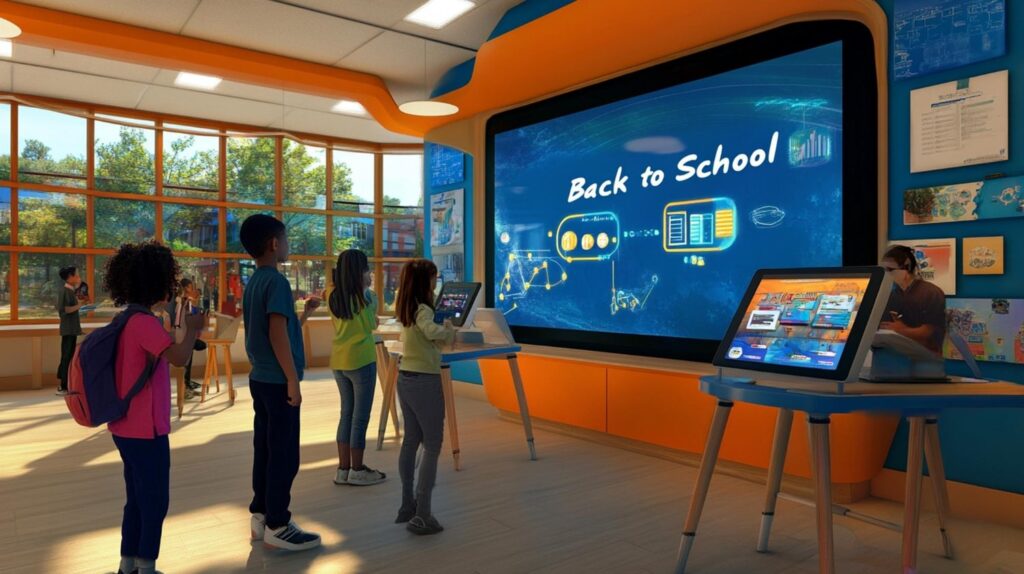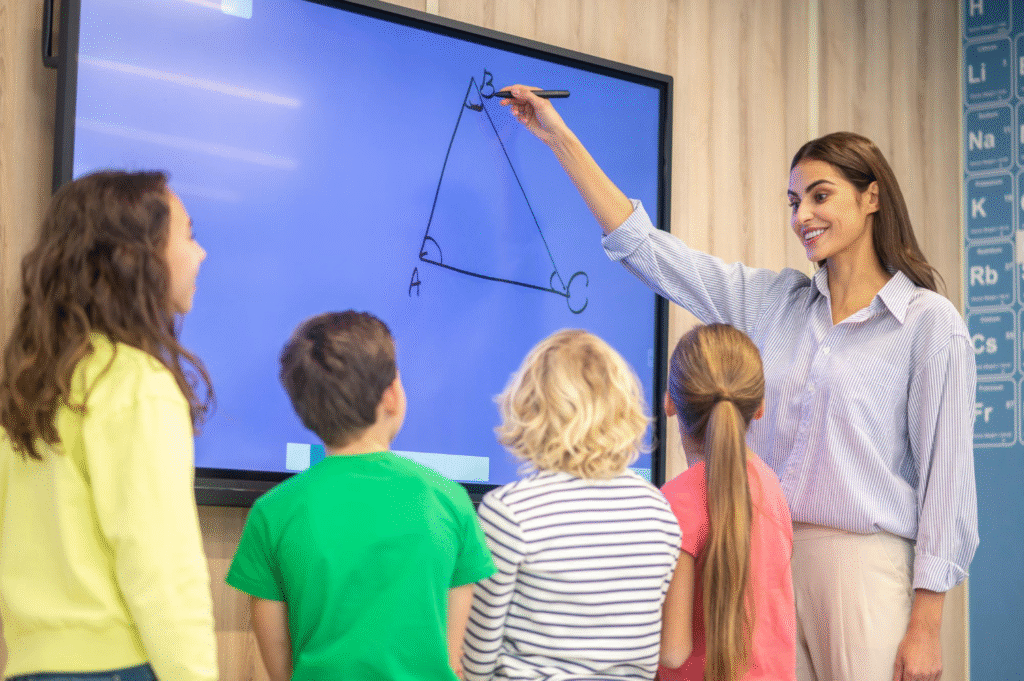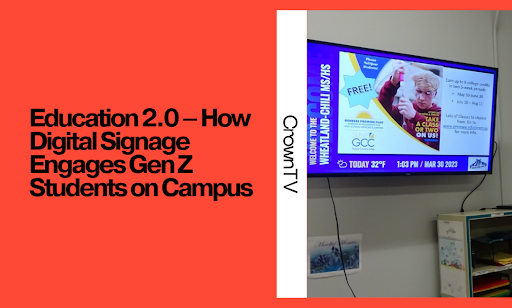The classroom isn’t the only place students are learning anymore. Attention has shifted—to screens, feeds, and moments that feel personalized. Traditional bulletin boards and flyers? They don’t stand a chance.
Gen Z doesn’t wait to be told what’s happening. They expect it—fast, visual, and on their terms. That’s where digital signage changes the game. When used right, it doesn’t interrupt campus life—it becomes part of it.
We’ll break down how digital signage connects with today’s students and why it’s becoming the most effective communication tool across U.S. campuses. You’ll see how it boosts engagement, builds community, and keeps information flowing without feeling forced.
Here’s what we’ll cover:
- How digital signage captures Gen Z’s attention through interactive visuals
- The psychological triggers that make screen-based communication so effective
- Ways campuses use dynamic displays to share news, events, and social updates
- How advanced signage tech personalizes the on-campus experience
In the end, you’ll know exactly how the right screen strategy turns passive passersby into active participants in campus life.
How Digital Signage Captures Gen Z’s Attention Through Interactive Visuals
Gen Z doesn’t just consume content — they respond to it. Raised on touchscreens, live streams, and short-form video, this generation’s attention is wired for interaction, not observation. On U.S. campuses, static posters and plain slides rarely register. But a screen that reacts, invites, and updates in real time? That’s a magnet for attention.
Digital signage taps into this behavioral shift by blending motion, color, and immediacy. Visuals that move — even subtly — trigger the human brain’s orienting response, prompting students to look up and engage. When that motion connects with something personally relevant, attention transforms into action.
The Subconscious Pull of Interactivity
Gen Z students respond to control and feedback. They value participation over passive viewing, and interactive signage meets that expectation through:
- Touch-responsive interfaces that let students explore content instead of waiting for it to loop.
- QR-integrated displays linking physical spaces to digital updates — events, schedules, or class resources.
- Social media walls showcase peer posts, creating a real sense of inclusion.
- Gamified visual prompts — polls, quizzes, or challenges that reward quick interaction.
Each element creates a small feedback loop: action, reward, satisfaction. It’s the same cycle that makes them scroll through social feeds or tap through stories — now used to strengthen on-campus communication.
Visual Language That Speaks Their Mindset
To reach Gen Z effectively, digital signage must align with their media habits: fast, expressive, and visually layered. Consider:
| Element | What Works Best | Why It Captures Attention |
| Color & Contrast | Bold hues with gradient transitions | Reflects the energetic, digital-first design styles they prefer |
| Motion Graphics | Subtle animations or parallax effects | Keeps focus without overwhelming viewers |
| Microcontent | Bite-sized messages under 7 seconds | Matches their short attention window |
| User Content | Peer-generated visuals and clips | Builds trust and relevance instantly |
The combination of dynamic visuals and interactive cues turns information into experience. Instead of scanning a screen, students connect with it — making digital signage one of the few communication tools that fits seamlessly into their visual rhythm and attention style.
The Psychological Triggers That Make Screen-Based Communication So Effective

Screen-based communication isn’t accidental in its impact—it’s built on a foundation of cognitive science and visual psychology. For Gen Z students, whose learning, entertainment, and social interactions are dominated by screens, digital communication aligns with how their brains naturally process and retain information.
At its core, effective screen-based engagement depends on how the human mind reacts to motion, color, relevance, and social validation. When these elements align, attention converts into comprehension and action.
How the Brain Reacts to Motion and Visual Hierarchy
Research from the Nielsen Norman Group shows that humans process visuals up to 60,000 times faster than text. That speed matters in environments where attention spans average just eight seconds, according to a 2023 Microsoft consumer study. Motion and visual hierarchy—like progressive animations or color-coded sections—guide the eye smoothly through information, minimizing cognitive effort and boosting recall.
A well-structured digital screen triggers three key neurological responses:
- Orientation response – automatic attention to new or moving stimuli.
- Cognitive fluency – comfort in processing visually simple, organized messages.
- Reward anticipation – satisfaction from engaging visuals that lead to a clear outcome.
These psychological mechanisms explain why a report found that digital signage improved student awareness of campus events by 38% compared to traditional noticeboards.
Emotional and Social Triggers That Strengthen Engagement
Visual design alone doesn’t sustain engagement. Emotional relevance—paired with social proof—keeps attention active. Gen Z students respond more strongly to messages that feel authentic and socially validated. Screen-based media naturally support that through real-time, personalized, and participatory formats.
| Trigger | How It Works | Practical Application on Campus |
| Reciprocity | The brain rewards interaction that feels mutual. | Touch-based screens or polls that display collective results. |
| Social Proof | Seeing peers participate builds trust and curiosity. | Live feeds showing student events or organization updates. |
| Novelty | The brain releases dopamine when presented with new visual stimuli. | Regularly refreshed layouts or content loops. |
| Relevance | Contextually timed content increases information retention. | Location-based messaging for classrooms or dorms. |
When these triggers combine, screens move beyond simple information delivery. They create experiences that reflect how Gen Z communicates, learns, and connects.
How College Campuses Use Dynamic Displays to Share News, Events, and Social Updates
Across universities and colleges, digital signage has become the preferred way to distribute campus-wide information efficiently. Instead of relying on bulletin boards, mass emails, or printed flyers, dynamic displays deliver fast, visual updates where students naturally gather—hallways, cafeterias, libraries, and residence halls.
Gen Z students process information visually and prefer instant updates over text-heavy announcements. Dynamic displays meet that expectation by combining visual storytelling with real-time communication. This approach turns passive walls into active sources of news, engagement, and community building.
Centralized Communication Made Visual
Digital signage allows campus departments, student organizations, and administration to share important updates across multiple screens at once. Messages can be scheduled, customized, or localized by building or department. Typical content includes:
- Upcoming events and club meetings to boost attendance and participation.
- Campus safety notifications are used to communicate alerts quickly and clearly.
- Academic deadlines and schedule changes are displayed near high-traffic academic zones.
- Sports highlights and achievements to strengthen school spirit and visibility.
This level of coordination creates a unified communication channel—consistent messaging that stays visible and current throughout the day.
Building Social Connection Through Visual Media
Dynamic displays also serve as digital community boards, reflecting student life in real time. They make it easier for students to stay informed and connected without depending on emails or social media feeds.
Key uses include:
- Social media integration, where curated student posts, photos, or campus hashtags appear on rotation.
- Digital shoutouts for achievements, birthdays, or campus milestones that celebrate individuality and teamwork.
- Interactive displays that encourage quick participation in polls, surveys, or giveaways.
- Departmental takeovers allow student groups to share updates directly with their peers.
When thoughtfully implemented, these displays create a shared sense of identity. They turn everyday communication into a visual rhythm that mirrors how Gen Z already interacts—through screens, stories, and quick bursts of information that invite a second look.
How Advanced Signage Tech Personalizes the On-Campus Experience

The newest generation of digital signage is built around intelligence, adaptability, and data-driven personalization. In 2025, educational institutions across the U.S. are using advanced technologies to tailor content for specific audiences and moments. These tools don’t just display information—they shape experiences that respond to context, behavior, and need.
Artificial intelligence, automation, and cloud synchronization have made signage systems smarter than ever. Messages no longer remain static. They evolve based on the time of day, location, or type of viewer standing nearby. This level of personalization makes communication more relevant, efficient, and engaging, driving stronger student engagement through every on-campus interaction.
Smart Technology That Responds in Real Time
AI-enabled signage systems process multiple data inputs—from student schedules to building occupancy—to deliver meaningful content automatically. This technology ensures that the right message appears at the right place and time, creating dynamic digital content that connects instantly with its audience.
Key applications include:
- Predictive scheduling that adjusts content rotation according to class hours, traffic flow, or seasonal events.
- Facial recognition or anonymous analytics that track engagement levels and audience demographics while maintaining privacy.
- Smart sensors that trigger contextual messages, such as event reminders when students pass near auditoriums.
- Integration with campus systems to display live transit schedules, dining hall capacity, or emergency alerts.
Each function transforms signage into a living communication channel—context-aware and effortlessly adaptive.
AI-Driven Personalization and User-Centric Design
Beyond automation, artificial intelligence fine-tunes visuals and tone to match audience preferences. It can analyze which content types—videos, motion graphics, announcements—gain higher interaction rates and then optimize future displays automatically.
Personalization strategies include:
- Dynamic content curation based on student behavior and interest trends.
- Localization of visuals for specific departments, dorms, or activity centers.
- Language adjustments that switch automatically based on demographics or regional diversity.
This fusion of intelligent software and visual design ensures every message feels intentional and current. Instead of broadcasting to everyone, advanced signage technology in 2025 communicates with each viewer, creating an experience that feels timely, connected, and personal.
The Leader in Advanced Campus Signage Across the USA
Across the United States, CrownTV has become the benchmark for advanced, education-driven digital signage solutions. While most providers focus on hardware or software in isolation, CrownTV integrates the entire ecosystem — from dynamic display management to turnkey installation — into one cohesive platform.
This makes it the only digital signage provider in the U.S. offering purpose-built solutions for college campuses, as well as for industries like retail, healthcare, hospitality, agriculture, weddings, religious organizations, malls, and food services.
Modern campuses need a signage infrastructure that goes beyond static announcements. They require a connected network that delivers critical information, automates campus activities, and scales with institutional growth. CrownTV’s technology achieves this by combining intelligent software, powerful media players, and advanced deployment strategies that transform screens into data-driven communication systems that keep current students informed and up to date with every event.
Integrated Software That Manages Every Display Intelligently
CrownTV’s digital signage software serves as the control hub for educators, faculty, and communication administrators — enabling multiple users to manage displays across departments efficiently. Built for multi-location and multi-user management, it allows administrators to:
- Schedule and automate content across buildings, classrooms, or dormitories using a unified dashboard.
- Segment screens for different audiences — admissions, student affairs, libraries, or new students — ensuring each location shows context-specific, relevant information.
- Sync with existing campus systems to share important announcements, events, and wayfinding information in high-traffic areas.
- Control access permissions so departments can contribute and collaborate while maintaining brand consistency.
This architecture supports operational efficiency, providing an invaluable tool that keeps communication organized and timely across the campus community.
Media Players That Deliver Power and Precision
At the core of every display is CrownTV’s digital signage player, a compact yet high-performance device engineered for reliability and scalability. These players handle content templates, HD streaming, and real-time updates without interruption, ensuring messages remain clear and eye-catching in any setting.
They also support advanced functionality essential for technology continues to evolve on campuses in 2025:
- Remote updates and maintenance that reduce on-site intervention.
- Secure connections to protect sensitive institutional data.
- Adaptive performance to optimize playback depending on screen configuration and network conditions.
Each player is plug-and-play ready, giving IT teams the ability to install, relocate, or expand systems easily as the campus grows — improving both student experience and daily student work.
Seamless Installation and Scalable Deployment
Deploying signage across large academic environments requires precision and expertise. CrownTV’s display installation and rollout service takes care of every technical detail — from strategic placement in high traffic areas to network optimization and configuration.
This service covers:
- Hardware sourcing and configuration, ensuring each screen is positioned for maximum visibility and accessibility to visitors and students.
- Professional installation, including cabling, mounting, and system synchronization.
- Ongoing project management, aligning each phase with campus timelines and departmental goals.
Through efficient coordination, CrownTV helps institutions navigate installation challenges with ease, ensuring every screen contributes effectively to the university experience.
Customization Through Apps and Content Integration
Every campus communicates differently, which is why CrownTV’s app integrations support complete customization. With a growing library of applications, campuses can integrate interactive maps, social feeds, or digital directories that navigate directions and promote campus activities across multiple departments.
Examples include:
- Event calendar widgets to promote participation.
- News tickers and dashboards that share important announcements in real time.
- Advertising integrations for local partners or campus programs.
- Custom content templates that match institutional branding.
This level of customization allows institutions to contribute directly to their visual identity while ensuring content remains accessible, dynamic, and engaging.
CrownTV’s innovation-driven infrastructure makes digital signage more than a communication platform — it’s the foundation of a smarter, connected campus. By merging advanced software, powerful media players, and strategic placement, CrownTV enables universities to deliver relevant information, improve student experience, and guide both new students and visitors with clarity.
The result is a digital environment that enhances every interaction, keeps everyone informed, and strengthens the sense of connection across the entire campus community.
Make Campus Communication Smarter with Digital Signage
Digital signage has redefined how modern campuses operate—shifting communication from static to strategic. Institutions that once relied on bulletin boards and printed schedules are now building smarter, student-first ecosystems where information flows seamlessly, engagement feels natural, and technology supports rather than distracts.
When implemented well, this approach drives measurable improvements. Students stay informed without effort. Event attendance increases. Important updates reach everyone, everywhere, instantly. The campus becomes a living network—visual, responsive, and connected to how Gen Z already consumes content.
Here’s what this transformation produces in real terms:
- More engaged students who connect with dynamic, interactive content instead of ignoring it.
- Faster communication cycles that replace fragmented channels with unified, on-screen systems.
- A stronger campus identity built through consistent, branded messaging across multiple locations.
- Better efficiency for staff through automation, scheduling, and centralized control.
- Personalized experiences shaped by AI, data, and context-driven display technology.
In this evolution, CrownTV stands as the trusted partner for institutions that want intelligent, secure, and scalable signage systems. With its advanced software, high-performance media players, flexible app integrations, and full-service installation support, CrownTV helps campuses—and businesses beyond education—build environments where technology and communication finally work in sync.

